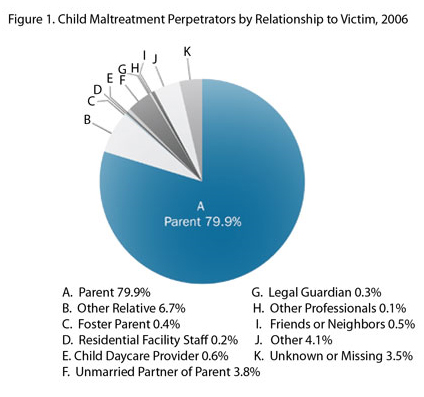|
It is a myth that strangers most often abuse
children. By far the vast majority of maltreated children
are victimized by those who are familiar to the child and
who have ready access to the child. Relatives of the child
are most often the perpetrators of child abuse. In particular,
parents make up the majority of child abuse perpetrators.
Approximately 80% (79.9%) of perpetrators were parents. Of
the parents who were perpetrators, more than 90% (91.5%) were
biological parents, 4.2% were stepparents, and 0.7 percent
were adoptive parents. Other relatives accounted for an additional
6.7%; unmarried partners of parents accounted for 3.8% (USDHHS-ACF,
2008).

Courtesy of the Children's Bureau, Administration
for Children and Families, US Department of Health and Human
Services (2008)
Female perpetrators, mostly mothers, were typically younger
than male perpetrators, who were mostly fathers. The median
age for women perpetrators was 31 years; for men, it was 34
years. Women also comprised a larger percentage of all perpetrators
than men, 57.9% compared to 42.1% (USDHHS-ACF, 2008). Nearly
76 percent of all perpetrators of sexual abuse were friends
or neighbors and 30 percent were other relatives. Less than
3 percent of parental perpetrators were associated with sexual
abuse (USDHHS-ACF, 2008).
The racial distribution of perpetrators was similar to the
race of their victims. During 2006, more than one-half (53.7%)
of perpetrators were White and one-fifth (20.7 %) were African-American.
Approximately 20% (19.5%) of perpetrators were Hispanic (USDHHS-ACF,
2008).
More than one-half (60.4%) of all perpetrators were found
to have neglected children. Slightly more than 10 percent
(10.3%) of perpetrators physically abused children, and 7.0%
sexually abused children. Almost 12% (11.5%) of all perpetrators
were associated with more than one type of maltreatment (USDHHS-ACF,
2008).
In New York State, in 2006, there were 106,419 substantiated
perpetrators of child maltreatment (USDHHS-ACF, 2008).
Continue on to
|